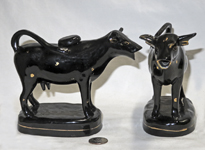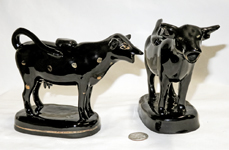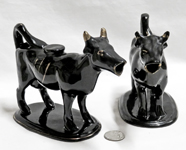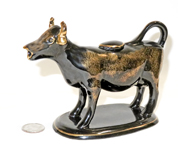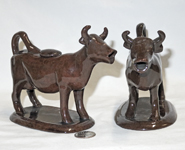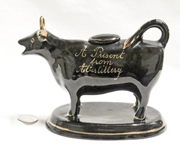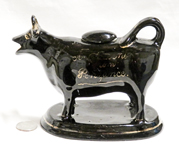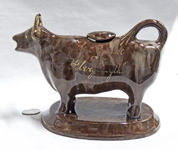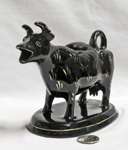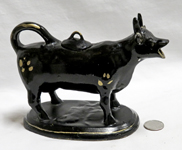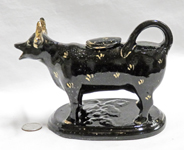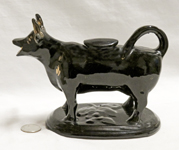Jackfield
Jackfield is a small village on the south bank of the River Severn, in the Ironbridge Gorge in Shropshire,
England. According to a knowledgable webpage (
https://craftshero.com/jackfield-pottery/ ),
mining and pottery manufacture were well established there as early as the mid-15th century. From what I
have been able to glean from the web, Jackfield has two main claims to fame in pottery, one being that it
is a noted center for decorative wall and floor tiles (there is a Jackfield Tile Museum), and the second a
glossy black glaze which is what characterizes these cow creamers. The Glass and Pottery Sellers
Association Newsletter of June 2005 notes:
“Jackfield wares originated in the town of Jackfield, in Shropshire, England, in 1740 to 1780. The
original earthenware was a thin-walled gray to purplish-black clay, and covered in a glossy black lead
glaze. It was also known as jet ware, blackware, or japanned ware, after the
Japanese black lacquer pieces. In addition to the goods made in Jackfield, it was also produced by Thomas
Whieldon in Staffordshire, Wedgwood, and others. The pieces made by Whieldon have a more reddish colored
body. Shards of this pottery found in Maryland and Florida have led historians to possible early English
settlements where little other documentation exists.”
Both in the UK antique shops that I have visited and on eBay, the term Jackfield seems to be applied to
earthenware cow creamers with the shiny black glaze, that are quite similar in many cases to the other
‘Staffordshire’ ones in the sense of having a lid and usually being on an oval base. They presumably date
from the late 19c or early 20c, i.e., the Victorian era, or at least are sold as such. I have a feeling
that some of mine are earlier (and likely some much later!), but have really no way of sorting most them
either by date or by locale of manufacture. Per usual, I’d appreciate any further information anyone can
provide on the ones in my collection, or on ‘Jackfield’ cow creamers in general.
While the one in the first section below seems (based on my shopping in England as well as what appears
frequently on eBay) to be the 'classic' and most common version of a Jackfield cow creamer, they do come in
an assortment of shapes, and a whole lot of variants within each of those themes. All however seem to have
more or less oval bases, relatively simple lids, and gold decorations although those have frequently been
rubbed off in whole or part through use. I should also repeat an earlier note on price: They were rather
dear and somewhat scarce in (50 GBP and up) in English antique stores when I lived there in the mid 90's,
once ebay kicked in the value has plummeted simply because there are so many of them. Seems like everyone's
grandmother or great grandmother had one, and the modern generation has little fondness for such keepsakes.
There are generally dozens for offer on ebay at any given time.
Two final notes: First, I photographed all of these against a light yellow background, but had to really fiddle
with some of them in photoshop to get the gold gilding and writing to show. Thus some backgrounds look
really washed out. Second, as a reminder, if you click on any of the thumbnails you will get a larger
picture.
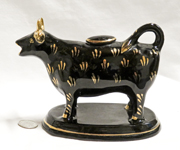 |
This is an example of the classic Jackfield cow creamer form that seems to be most common: wide open
mouth, large horns curved up-and-in that seem to come out of the ears, a rounded and somewhat subdued
udder, and an oval base with a flat top. They usually (unless it’s been rubbed off) have gold
gilding on the horns and ears, around the mouth, eyes, tail tip and rim of both base and lid; plus
sets of three gold slashes (almost like the top of a fleur-de-lis) liberally around the body. As
noted in the introduction, for those actually made in Jackfield the clay, which is usually visible on
the bottom of the lid and occasionally under the base, is a dark brownish- or blackish- purple.
|
Here is a very different and fairly common version – ears and horns to the side in a sort of
bat-wing shape, long teats coming straight out of the body, and gold dots rather than slashes. I
bought this beautiful pair from a Toronto dealer at the Baltimore Antiques Fair in 1999, and one of
them bore a British Antique Dealer’s label that stated “Certified produced prior to 1847”.
|
Here are four more examples of this shape creamer, with minor
variations such as size, shape of the face and teats, and gilding. I rather like this form. I was excited to get my first one from a small antique shop in
the English countryside (Dorking), and paid 110 GBP for it even though it had no lid. I remember the dealer's wife asking him if he
really wanted to part with it. That could have been part of a sales pitch, although I had already
agreed to buy it so I tend to think she rather liked it herself. Now, if I had only known at the time
what ebay was going to bring in the way of prices...
|
|
This is a third type - thinner, with smaller ears and horns. These are much less elegant than the
previous two types and likely arose to meet growing demand at lower cost. There is much less gilding
on these, though I suspect that much of it hs been rubbed off by use. There even seems to have been writing on the left sides of these, perhaps like the "Presents" shown further down the page.
|
Here are two other versions of the 'thin' type - one with somewhat longer horns and ears (at least
the one that's showing - the other is stunted) and a fancy version with sprinkled gold gilt on the
body.
|
|
These four brown creamers, two with a lot of gold gilt and two plain, appear to be from the same
mold as the thin gilded black Jackfield just above. They are shown on the Staffordshire page, but
repeated here for comparison. Since the potteries in the town of Jackfield generally didn't produce
items in this color or glaze as far as I have been able to discern, I'd guess that all of this type
were made in Staffordshire - but then that's simply a guess.
|
Here's a fourth type. Creamers from this and similar molds are often found in black and white or or
brown and white, or with blue transfer prints. But once a mold is available, it's frequently used for
many purposes so it should be no surprise that they were also fashioned in the popular black
Jackfield or jet glaze. Plus they seem to be made from the typical Jackfild grey-black clay. The pair
in the right photo, whiuch are nearly identical to the one on the far left, came together and were sold with significant damage (thus were very inexpensive).
I restored them - one just to the lid and the other to both the lid and the upper lip. They came out
pretty well for an amateur. At one time they had gold writing on the left side – “A Present from
Pothyport” as best I can make out from the remaining faint traces, although I can’t find a town by
that name so I'm pretty sure I've got it wrong.
|
Jackfield creamers in what I'm calling the classic form apparently were popular souvenirs – presumably starting
during the Victorian era. They bear in gold script “A Present From …” on one side, and the triple
slash marks on the other. The one shown here is from Abertillery. Wikipedia tells us that Abertillery is Welsh for mouth of the River
Tyleri. It’s the largest town of the Ebbw Fach valley in the historic county of Monmouthshire, Wales,
now part of the Blaenau Gwent County Borough administrative area. The surrounding landscape borders
the Brecon Beacons National Park and the Blaenavon World heritage Site. Formerly a major coal mining
centre, the Abertillery area was transformed in the 1990s using EU and other funding to return to a
greener environment.
|
|
Here are two more classic Jackfield souvenir cows: one from Penzance with faded gold, and one from
Teignmouth. Per Wikipedia, Penzance is the most westerly major town as well as a civil parish and
port in Cornwall, in the very far southwest of England. Situated in the shelter of Mount's Bay, the
town faces south-east onto the English Channel, is bordered to the west by the fishing port of
Newlyn, to the north by the civil parish of Madron and to the east by the civil parish of Ludgvan. ‘Pennsans’ means "holy headland" in the Cornish language and refers to the location of a chapel
nowadays called St Anthony's that is said to have stood over a thousand years ago on the headland to
the west of what became Penzance Harbour. The first mention of the name Pensans is in the Assize Roll
of 1284, and it was granted various royal charters from 1512 onwards and incorporated on 9 May 1614.
Teignmouth is a large seaside town, fishing port and civil parish in the English county of Devon,
situated on the north bank of the estuary mouth of the River Teign about 12 miles south of Exeter. In
1690, it was the last place in England to be invaded by a foreign power. From the 1800s onwards, the
town rapidly grew in size from a fishing port associated with the Newfoundland cod industry to a
fashionable resort of some note in Georgian times, with further expansion after the opening of the
South Devon Railway in 1846. Today its port still operates and the town remains a popular seaside
holiday location.
|
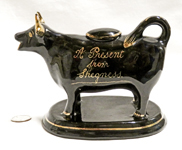
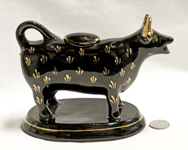


On top is one from Skegness, and below it one from The Potteries. Skegness is a seaside town and
civil parish in the East Lindsey district of Lincolnshire, England, on the Lincolnshire coast of the North
Sea. It was primarily a fishing village and small port before the arrival of the railway in 1875. In 1908,
the Great Northern Railway commissioned a “Skegness is so Bracing” poster to advertise excursions to the
resort, featuring the Jolly Fisherman who helped to put Skegness on the map and is now famous. The world's
first Butlin's holiday resort opened in Skegness in 1936, and it remains a popular tourist venue. There are
other cow creamer momentos from Skegness on the Advertising and Souvenirs page. It's very popular. You can
learn all about “The Potteries” – the center of English china and earthenware production - in the
introduction to the Staffordshire page and from their superb website, www.thepotteries.com. I have a
souvenir ‘kent’ style creamer made for sale at the famous Stoke-on-Trent Museum and Art Gallery, and i
wonder if this Jackfield version was similarly made for them – if so, it’s likely quite modern and of
course would be molded, glazed, and gilded in the classic fashion. It's sort of interesting that the Potteries put the writing on the right side of their cow while all the others have it in the left; and also unlike them, it doesn't claim to be a 'Present'. '
|

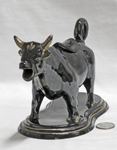
This is a very unusually shaped Jackfield - it's the only one I've seen with this form of base, and the cow seems to be leaning forward and actually appears quite fierce due to the shaping of the head. It has the normal 3-slash gold decorations on the right, but until I looked closely appeared to be blank on the left. I then discovered that it at one time read "A present from Goldthorpe", but the gold is completely gone, leaving only a very dim outline. Wikipedia tells us that Goldthorpe , a South Yorkshire village in the metropolitan borough of Barnsley, in ancient times was a small medieval farming village. It later became a major coal mining area until the closure of the mines in the 1980s, since when it has been 'deprived'. Not the best place for a holiday to be remembered, at least not recently. The lid on this creamer had been broken and reglued, and had a chip that I tried somewhat unsuccessfully to restore. But it had the great advantage of an extremely low price and it is unique, at least for my collection.
|
This creamer, like the brown ones up the page, could and perhaps should go on the Staffordshire page but I decided to put it here in spite
of the Rockingham or treacle glaze, as an example of one that’s nearly identical in shape to the classic
souvenir black Jackfield cows like those above, and that bears a similar marking: “A Present from
Aberystwyth”. Aberystwyth, literally "Mouth of the Ystwyth" is an ancient and somewhat isolated market
town, administrative centre, and holiday resort in Ceredigion, Wales. It has also been a major Welsh
educational centre since the establishment of a university college there in 1872. Aberystwyth has a pier
and a seafront which stretches from Constitution Hill, at the north end of the Promenade, to the mouth of
the harbour at the south, taking in two separate beach stretches divided by a castle. Whether this creamer
is really from one of the Jackfield potteries I have no way of knowing – and of course molds were passed
around or copied quite a bit.
|
Did I really need another Jackfield cow? This is my 32nd…but then I hadn’t bought one for ~3 years, plus this
one is in very good condition, and it is a bit different. Its base and body (including small udder and
distinct teats, as well as the gold decoration) appear to be identical to the ‘Present’ cows shown above.
However the head is different – smaller ears, shortened face with wide open mouth, and horns curled
straight forward. Plus, since there are so many of these Jackfield cows available these days – lots of
folks trying to offload great-grandma’s stuff – the price was eminently reasonable.
|
Here are examples of more variations on the classic form - one with a loop on the lid, and the other with white
speckles. I have seen other forms of lids but only this one with speckles. I have no idea if they were
intentional or if it got caught in a paint spitting contest. Both of them have raised but poorly defined
'flowers' on the tops of the bases, which to me implies that they are likely later versions since these
types of bases are fairly common on many of the 20c Kent style creamers. The one with the ringed lid also
has very different gilding, just some spots on the rumps and shoulders, and its coating is quite rough. Not
the highest quality cow by any means.
|
Three more variants - two close to the classic form, and the third shorter with a different head, small
horns and ears, and a bit of sprinlked gold gilt in several places.I believe it has a replacement lid,
and I can't tell what kind of clay it is made from.
|
|
Here’s an unusual one with a textured coat and a differently shaped base, but more or less the same
general body form and gold decoration (some has rubbed off over the years). I believe it is intended to
represent a shaggy Scottish highland cow. There is a brown cousin along with this one on the Staffordshire page.
|
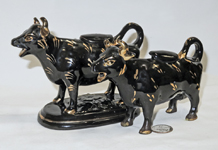
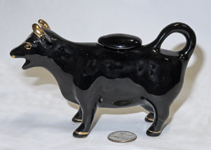
To conclude this page, here are three creamers of very different style but with Jackfield glaze. The two
on the left are what I have referred to as 'Kent' style (there are a bunch on the Staffordshire page), but
bearing traditional Jackfield gold decorations. The one with the base has the raised flower which is typical of
this form of cow creamer. As noted elsewhere, this style of creamer was and remains quite popular and
widely produced. I don't know if these two came from a pottery in Staffordshire or are actually from
Jackfield, but since they are made from the purplish black clay, I will assume the latter until corrected. While it's almost impossible to determine their age, the one without the stand (rather, one just like it) came via Ebay from a 'Boston museum worker who carefully documented everything', and said it was purchased in Chester, England in 1911.
On the right is a cute little guy without a base, and a still different form of body. Although unmarked (except for am "R" inscised into the bottom of the front left hoof), it is from the same mold as a brown and white one marked for "Sandland, Made in Staffordshire", shown on the Stafordshire page, so I assume it is from them.
|
|



